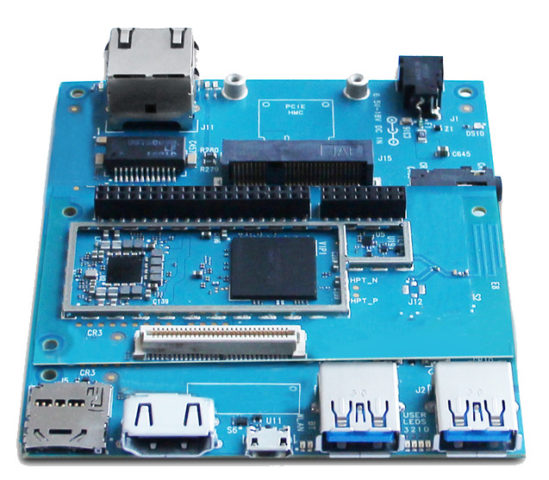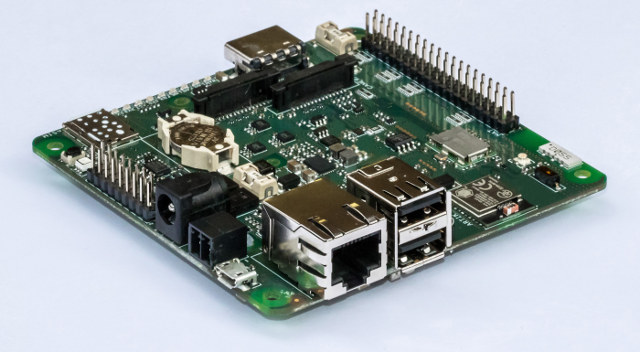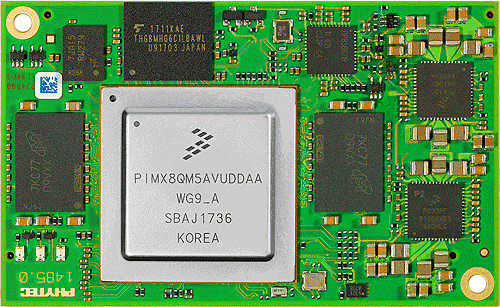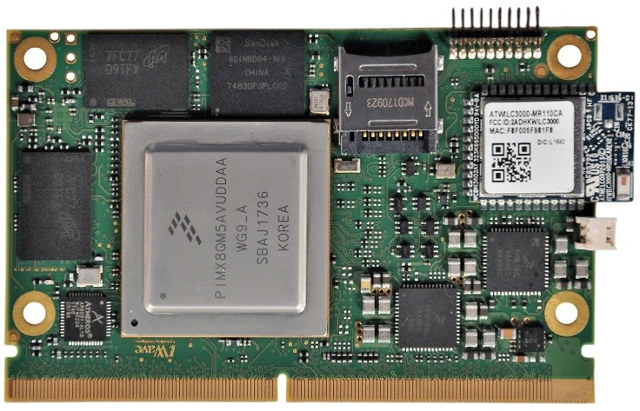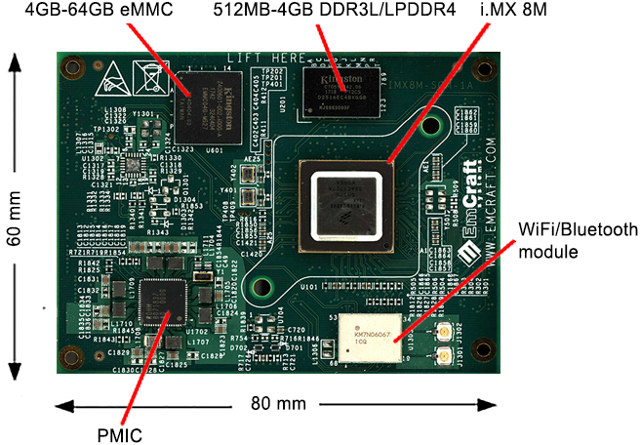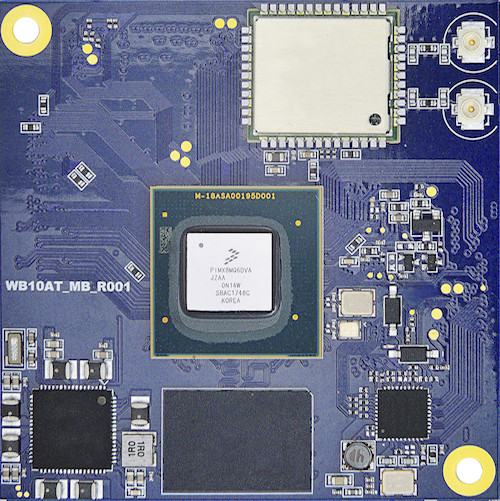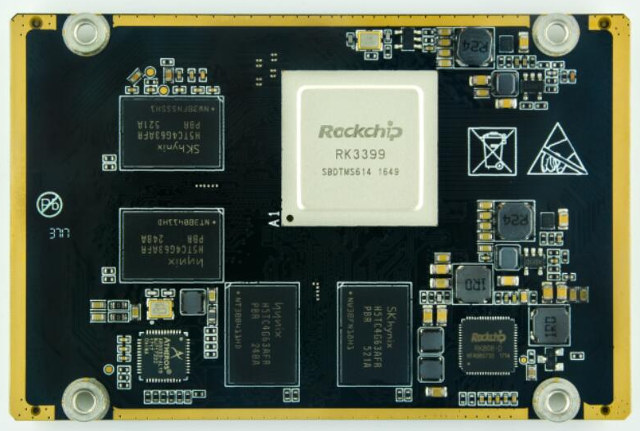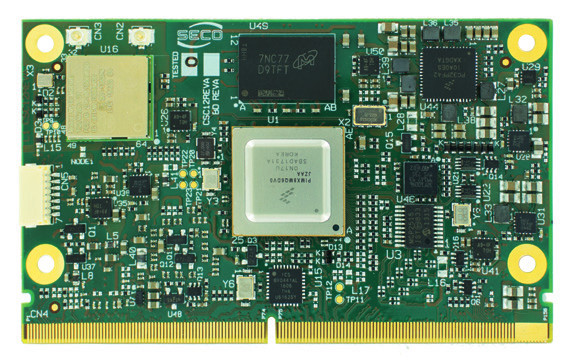Qualcomm Snapdragon 820E processor was recently launched a version of Snapdragon 820 without LTE modem, easier to source, and targeting the embedded market. The long expected DragonBoard 820c is the first board to feature the new processor, but Geniatech has also been working on their own Developer Board 8 that follows 96Boards CE Extended form factor, and is very similar to DragonBoard 820c. Developer Board 8 (DB8) specifications: SoC – Qualcomm Snapdragon 820E quad core Kryo processor up to 2.35 GHz with Adreno 530 GPU System Memory – 3 GB LPDDR4-1866 (PoP) Storage – 32 GB UFS Flash + micro SD 3.0 (UHS-I) slot Video Output – HDMI 2.0 up to 4K @ 60 Hz Audio – Via HDMI, 3.5mm audio jack Connectivity – Gigabit Ethernet, 802.11 b/g/n/ac WiFi, Bluetooth 4.2, GPS (TBC) USB – 2x USB 3.0 ports, 1x micro USB 2.0 device port Camera – Support for up […]
BalenaFin is an Industrial Carrier Board for Raspberry Pi CM3L Module Designed for Fleets of Connected Devices
[Update January 2019: Resin.io Project Fin has been renamed to BalenaFin, I have not changed the rest of the article] Resin.io is a both a company and a software platform that includes device, server, and client software to get code securely deployed to a fleet of devices. Devices are setup to run ResinOS, and to deploy you app, you just need to push the code to resin.io build servers, where it will be packaged into containers and delivered to your fleet of boards. So far, resin.io relied on existing hardware platforms like Raspberry Pi 3, BeagleBone Black, or Intel NUCs, but they’ve now decided to launch their first hardware with Project Fin that takes a Raspberry Pi Compute Module 3 Lite, is hardened for field deployment use cases, and adds some of most commonly requested hardware features such as variable supply voltage support, RTC, and cellular connectivity (via mPCIe card). […]
PHYTEC Introduces phyCORE SoMs & Devkits Based on NXP i.MX8, i.MX 8M, or i.MX 8X Processors
PHYTEC, an embedded systems company headquartered in Germany with global offices, has updated their phyCORE systems-on-module family with 3 sub-families of modules based on NXP i.MX 8, i.MX 8X, or i.MX 8M dual or quad core processors for a total of 9 modules. phyCORE-i.MX 8 Specifications: SoC – NXP i.MX 8Quad, i.MX 8QuadPlus or i.MX 8QuadMax Arm Cortex-A72/A53/M4F processor @ up to 1.6 GHz with Tensilica HiFi 4 DSP @ 666 MHz, 2x Vivante GC7000XSVX GPUs System Memory – 1 to 8GB LPDDR4 RAM Storage – 64MB to 256MB Octal SPI/DualSPI SPI NOR Flash, 4 GB to 128 GB eMMC flash, 4kB EEPROM Connectivity – 2x Gigabit Ethernet PHY 4x 120-pin Board-to-board connectors with: Display – 2x LVDS, 2x MIPI DSI, 1x HDMI Video Input / Camera – 1x HDMI, 2x MIPI CSI Audio – 2x ESAI, up to 4x SAI Networking – 2x 10/100/1000 Mbit/s Ethernet USB – 1x […]
iWave Systems iW-RainboW-G27M SMARC 2.0 SoM Features NXP i.MX8 QuadMax Processor
We’ve previously seen SECO will soon launch SM-C12 SMARC 2.0 SoM powered by NXP i.MX 8M processor, but there’s not the only company working on a SMARC 2.0 compliant system-on-module powered by the latest NXP 64-bit Arm processor, as iWave Systems iW-RainboW-G27M module should be coming up soon with a more powerful NXP i.MX 8QuadMax Arm Cortex A72/A53/M4 processor coupled with 4GB LPDDR4 RAM by default. The i.MX8QuadMax SMARC System-on-Module targets “complex embedded application of consumer, medical and industrial embedded computing applications”. iWave Systems iW-RainboW-G27M specifications: SoC – NXP i.MX8 QuadMax processor with 2x Cortex-A72 @ 1.8 GHz, 4x Cortex-A53 @ 1.2 GHz,2 x Cortex-M4F @ 266 MHz, 2x Vivante GC7000XSVX GPUs, and a 4K H.265 decode & 1080p h.264 enc/dec capable VPU System Memory – 4GB LPDDR4 (Expandable) On-module Storage – 16GB eMMC Flash (Expandable), micro SD slot, optional 256MB QSPI Flash On-module Connectivity – 2x Gigabit Ethernet PHY, […]
Emcraft Introduces NXP i.MX 8M SoM and $299 Starter Kit
I first discovered Emcraft Systems in 2011 through their work porting uCLinux to Arm Cortex M3/M4 microcontrollers, and since then the company has kept on working microcontroller software and hardware, but also moved to Arm Cortex A class solutions. Like most embedded systems companies, Emcraft engineers have also designed their own NXP i.MX 8M system-on-module, but while many have still not announced pricing, and/or show “in development” or “early product announcement” in their product page, Emcraft has started taking pre-order for their i.MX 8M SoM Starter Kit for $299, with shipping scheduled for May 21, 2018 or before. Let’s check out SOM-IMX8M specifications first: SoC – NXP i.MX8M Quad processor with 4x Cortex A53 cores, 1x Cortex-M4F core, and a Vivante GC7000Lite GPU System Memory – 512MB to 4GB DDR3L/LPDDR4 SDRAM Storage – 4 to 64GB eMMC flash Connectivity – Wireless module supporting 802.11 a/b/g/n/ac 2×2 MIMO WiFi, Bluetooth 4.2, […]
Innocomm WB10 NXP i.MX8M Quad SoM Comes with WiFi, Bluetooth, and Ethernet Connectivity
Taiwan based Innocomm Mobile Technology has been working on their own NXP i.MX 8M quad core system-on-module – namely WB10 – which includes a wireless module with WiFi and Bluetooth, as well as a Gigabit Ethernet transceiver. The module connects to the carrier board through three 80-pin board-to-board connectors exposing many of the I/Os provided by the latest NXP processor. WB10 module specifications: SoC – NXP i.MX8M Quad processor with 4x Cortex A53 cores, 1x Cortex-M4F core, and a Vivante GC7000Lite GPU System Memory – 2GB LPDDR4-3200 Storage – 8GB eMMC flash Connectivity Gigabit Ethernet transceiver Wireless module supporting 802.11 a/b/g/n/ac 2×2 MIMO WiFi, Bluetooth 4.2, two u.FL antenna connectors on-module Power Management & Audio Codec – ROHM PMIC 3x 80-pin board-to- board (1.27mm pitch) connectors exposing: Display Interfaces – HDMI 2.0a with support for 4K HDR, MIPI DSI Audio Interfaces – 4x SAI, S/PDIF Rx/Tx, DSD512 Camera Interfaces – […]
OpenEmbed Launches $99 em3399 Rockchip RK3399 SoM, and a Compact Evaluation Kit
Looking for a system-on-module based on Rockchip RK3399 processor? So far, you had at least four options with either edge connectors or castellated holes: Theobroma RK3399-Q7 (Qseven) SoM, 9Tripod X3399 core, Boardcon PICO3399 CPU module, or Firefly-RK3399 CoreBoard. OpenEmbed now offers another RK3399 system-on-module with their em3399 SoM using board-to-board connectors interfacing with the carrier board. OpenEmbed em3399 system-on-module specifications: SoC – Rockchip RK3399 hexa-core processor with 2x Cortex-A72 cores, 4x Cortex-A53 cores, and a Arm Mali-T860MP4 GPU System Memory – 2GB or 4GB DDR3L RAM Storage – 16GB to 128GB eMMC 5.1 flash Connectivity – Gigabit Ethernet transceiver (Atheros AR8033) Power Management – Rockchip RK808D PMIC 2x 120-pin board-to-board connectors (0.8mm pitch) with: Display: HDMI 2.0 port with audio for up to 4K @ 60Hz DisplayPort 1.2 with audio for up to 4K @ 60Hz MIPI-DSI (dual-channel) at up to 2560×1600 @ 60 Hz eDP 1.3 (4-lane) Camera – […]
SECO Unveils SM-C12 SMARC 2.0 Compliant i.MX8M Module, CSM-B79 SMARC 2.0 Carrier Board
We’ve already seen several computers-on-module/systems-on-module based on NXP i.MX8/8M processors, most of which use proprietary standards, but so far we’ve covered at least on Qseven 2.1 CoM with Advantech ROM-7720 powered by i.MX 8QuadMax SoC. SECO has now announced their SM-C12 module compliant with another SoM standard: SMARC 2.0. The system-on-module is powered by i.MX 8M dual or quad core processor, supports up to 4GB RAM, offers optional WiFi and Bluetooth connectivity, and plenty of I/Os thanks to the 314-pin MXM3 connector mandated by SMARC 2.0 specification. The module targets home automation, transportation, digital signage and vending machines, multimedia devices, and others applications requiring real-time processing and/or multimedia capabilities. SC-12 module specifications: SoC – NXP i.MX 8M dual or quad Arm Cortex-A53 processor with Cortex-M4 real-time core, Vivante GC7000Lite GPU with support for OpenGL ES 3.1, Open CL 1.2. OpenGL 3.0, Vulkan, DirectX System Memory – LPDDR4-3200 memory, 32-bit interface, […]


